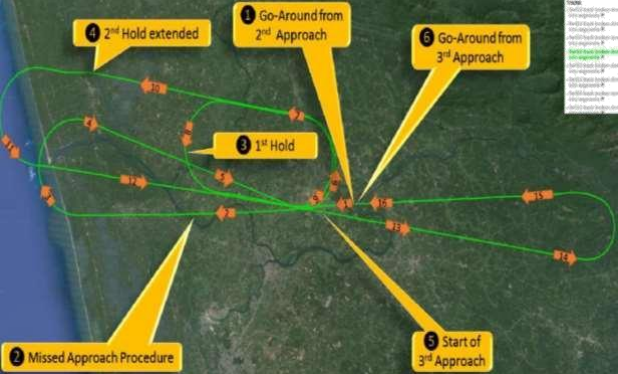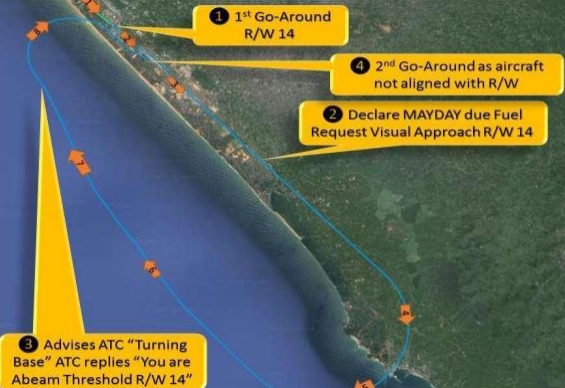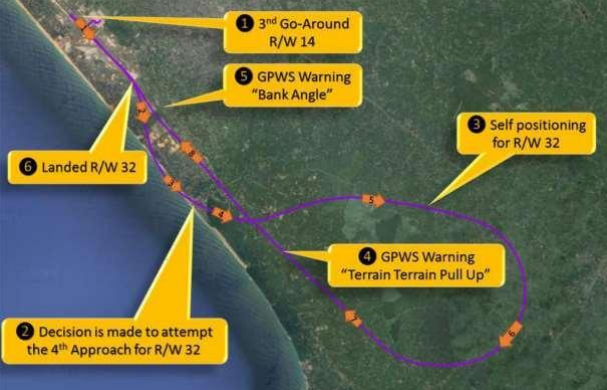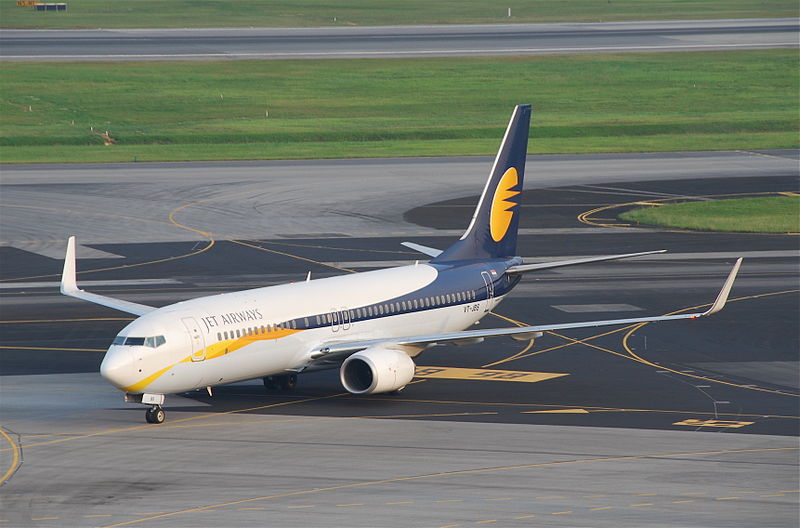On 18th August 2015, a Jet Airways 737-800 performed an unprecedented six go-arounds before landing safely on the seventh approach, albeit with insufficient fuel.
Flight Details
Jet Airways Boeing 737-800 - registered VT-JFA - took off around midnight from Doha, Qatar, destined for Cochin, India, as flight 9W555. However, the crew had to make three go-arounds in Cochin before diverting to Trivandrum Airport due to bad weather.
The pilots were cleared to land at runway 27 with an ILS approach at Cochin International Airport, allowing them to descend until it was 200 feet over the ground, something very useful in situations like this. The initial visibility was 3500m, and there were some clouds at 1500 feet, but when the pilots approached, they discovered that the weather was a lot worse. The crew couldn't see the runway or lights even at 320 feet. So they performed a go-around. This was the first go-around for the day.
The Boeing 737 was left with 4,699 kg of fuel, so the situation wasn't intense.
They had two options: Divert to a different airport or attempt to land here at Cochin again.
Bangalore was an option, which was 200 nautical miles away from their location, and the weather was very good there with a visibility of 8,000m. Another alternate airport was in Trivandrum, which was 100 nautical miles away. However, only a VOR approach could be made at Trivandrum airport. They got information that the visibility at Trivandrum was 3,000m which is just enough.
The crew decided to begin the second ILS approach at Cochin, which eventually didn't go as planned, and the aircraft performed go around for a second time. The fact that other aircraft also had trouble landing at Cochin was communicated to flight 555. However, instead of flying to Bangalore, the captain decided to perform a third approach in Cochin. But, the weather was getting worse every minute. The ATC even warned them about clouds, but the crew performed an unsuccessful third approach.

The Boeing 737 had 4,844kg of fuel when it entered Cochin Airspace, and it went down to 4,699 kg on the first go-around, 3,919 kg on the second and 2,644 kg on the third attempt.
Diversion to Trivandrum Airport - 3 More Go-Around!
After three unsuccessful attempts in Cochin, they only had 2,644 kg of fuel, which was insufficient to reach Bangalore. The crew then diverted to Trivandrum. However, the weather in Trivandrum wasn't so great either. This was informed to ATC at Cochin, but they never forwarded this message to flight 555. When they contacted Trivandrum, they were told that visibility was just 1500m.
The landing became tougher as the ILS approach wasn't available. As a result, the crew performed their fourth go-around. The aircraft was left with less than 1,324 kg of fuel onboard, which is the fuel reserve equivalent to 30 minutes of flight that can take them to the nearest airport. This much fuel should always be present in the aircraft, and if the number drops below this, they have to declare "May Day" and must land as soon as possible.

The crew then declared a "May Day" and requested a visual approach to runway 14. The Boeing 737 lined up using navigation displays only, without instrument guidance. However, this approach was also unsuccessful, and the crew performed go around for the fifth time. The crew performed a very similar approach again, but it was not successful, and the aircraft performed go around for the sixth time.
The Final Approach
After the sixth go-around, only 662 kg of fuel was left. At last, the pilot decided to approach runway 32, the runway at a different side.
The aircraft was flying just 700 feet above the ground, so low that the ground proximity warning system started to ring, which warned repeatedly, ‘Terrain, terrain pull up'.
But the crew couldn't follow these warnings as they were incredibly low on fuel. The captain made a "blind landing", risking the lives of those on board, ignoring all warnings and no visual contact of the runway, as bad weather prevented them from seeing the runway, as found by the investigation. It could have had disastrous consequences. Thankfully, nobody was injured, and the aircraft didn't sustain any damage.

As recorded in the cockpit voice recorder (CVR), during the seventh approach, the first officer was heard asking, “Do you know where it (runway) is?”
"Just going blindly," the captain replied.
They were left with only 349 kg of fuel when it eventually landed. Had the pilots gone for another go-around, they would have crashed due to insufficient fuel, officials said.
AAIB Investigation
Following this critical incident, an investigation was launched as the Aircraft Accident Investigation Bureau (AAIB) classified this as a serious incident. Various aspects were considered, such as the state of the aircraft, weather, fuel planning, decision making etc. The plane was in a good state, and its condition wasn't a reason for this incident. The initial fuel planning was also on the point. Fuel policy of Jet airways, weather, expected delays were also considered, and adequate planning was done.
The critical factor this incident revolved around was the weather. They were unable to land in Cochin due to poor weather and low-hanging clouds, and the same occurred in Trivandrum as well. The weather was getting worse every minute. Although the visibility was about 3000m in the initial approach, it dropped to 2500, and by the time they were approaching Trivandrum, it was just 2000m. The decision made by the crew could have resulted in this as well. The pilot in command dropped the idea of Bangalore to attempt a landing at Cochin one more time, and the selection of Trivandrum as an alternate airport where the VOR approach should be made are the highlighted points. Had the crew made better decisions early on, this incident wouldn't have occurred, as pointed out in the findings.
The tape from Cochin ATC that wasn't recorded couldn't be used in the investigation. The Trivandrum ATC inquired if the new weather conditions were informed to the diverting flight. But, there is no record of Cochin ATC relaying the information. There was no accurate transmission of information that the weather was getting worse, which Cochin ATC should have done. One other fault mentioned for the pilot in command is that the first officer had told about the VOR approach in Trivandrum, but the PIC ignored it. There wasn't any company policy for multiple go-arounds. So the decision to go around without diverting to Bangalore could have been stopped if a company policy existed. The crew also ignored several warnings from the aircraft, which put the safety of passengers and aircraft at risk.
In conclusion, the lack of company policy for missed approaches in inclement weather was considered the main reason for the incident. The safety of passengers and aircraft was also at stake as the aircraft had to ignore several warnings due to this. Also, the lack of policies that assisted them with designating new destinations could have been the reason, according to the final report. Following the incident, new guidelines were added to Jet airways. Also, new decision-making skills in such a scenario were taught. The pilots of flight 555 were grounded after the incident.
Jet Airways Statement
Jet Airways stated that the diversion to Trivandrum was a precautionary measure due to low visibility in Cochin, and the flight was operated following standard operating safety procedures.
“This is as per standard operating safety procedure. The flight landing with 141 guests was uneventful. At Jet Airways, safety is of paramount importance, and to this end, planning of flight operations are conducted with a very high level of safety. This includes a fuel uplift that not only meets all regulatory requirements, it has additional buffers to cater to unexpected scenarios including poor weather at the alternate airport."
Jet Airways Statement
Were you aware of this incident? Know of any similar events? Let us know in the comments.
Featured Image: Aero Icarus via Wikimedia Commons




